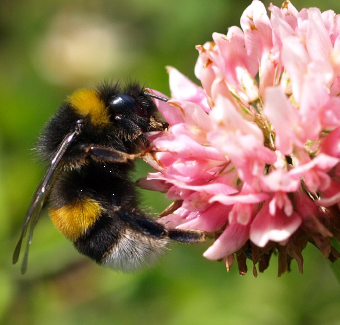Two seasons of “thinking like a bee” increase farmer awareness
The Beefarm project was initiated in collaboration with organic fruit and seed producers to bridge the gap between scientific knowledge and practice: How can the extensive body of knowledge on wild bees, bumblebees and solitary bees, be made operational in a farmer tool?

Farmers walk a route on the farm 3 times during the growing season, assessing food and nesting resources in all habitats expected to offer these resources within a 500 m distance from the apple plantation or clover seed field. Assisted by photo sheets with plants, farmers evaluate each habitat for the amount of bee food resources (flowers). Density measures are rough - no botanical analysis. If farmers and experts find approximately the same resources, the tool works.
The results from the two seasons are promising. However, we need a fine balance between data precision and manageable for farmers: How quick and simple should the tool be, if we also want to use it to prescribe action? Feedback provided by the farmers in workshops, after each season, is used to discover the weaknesses and to adjust the sheets and the routes. For instance, we had to adjust the way we describe the colors of flowers - “pink” doesn’t work.
Time consumption is another concern, but most farmers express that although it may be inconvenient in a busy farming life to use an hour just walking around, they appreciate to be forced to walk the farm and look closely around.
Difficult to make everyone happy
During the two seasons we trapped 67 species of solitary bees in traps set up systematically in the landscape around the organic orchards. Only 4 of these species were found on all of the 8 fruit farms, and all farms had several species which were unique for this farm. On clover seed farms we found a smaller number of solitary bees and less species (45) - of which a quarter was not found at all in the fruit farms. This is probably due to a combination of geographical and landscape differences, but knowing that the different bee species vary in their requirements for food and lodging, this illustrates that implementing actions benefitting all bees is impossible.
Food resources on the farm: The art of aggregating
Many studies, of food resources in farmland, use the potential of the various uncropped habitats as food providers. In addition to this we have assessed the actual food resources in the same habitats as the farmers evaluate. Therefore, we have a picture of the amounts and diversity of flowers found in each habitat during the season. When aggregating these results to illustrate “available food on the farm”, the plant species, their quality for various bee groups and the spatial distribution must be considered in addition to the quantity. Different bee species prefer different flowers. We have assessed the number of flowering plant species regardless of amount, in each habitat.
In the spring, which is critical to many of the solitary bees and when bumblebees are building up communities, the bees can find an average of 3,9 plant species in each habitat, ranging from 2,4 to 6,9 between farms. In the summer there is more to choose from: 6,3 plant species on average (range 4,4-8,9) and in the late summer the variation becomes much bigger around the average of 5,5 (1,8-9,2).
The challenge of implementation
Farmers want to act even though the connection between farm conditions and bee occurrence is not straightforward. Our results indicate that at least for the solitary bees the available nesting places may be a limiting factor. Almost all solitary bees trapped in orchards are soil nesting, and in organic orchards where no herbicides are used, lack of bare soil for nesting may be a limiting factor.
The project BeeFarm is part of the Organic RDD 2 program, coordinated by ICROFS (International Centre for Research in Organic Food Systems). It has received grants from the Green Development and Demonstration Programme (GUDP) under the Environment and Food Ministry
Visit the project website